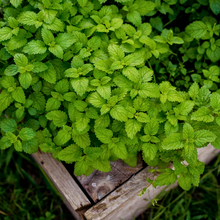Melissa officinalis, commonly known as lemon balm, is a fragrant and versatile perennial herb prized for its lemon-scented leaves and culinary and medicinal uses. This Melissa species features bushy, upright stems with oval-shaped, toothed leaves and produces small, white or pale pink flowers in summer. Its refreshing aroma and easy-going nature make it a valuable addition to herb gardens and kitchen gardens, adding a touch of citrusy fragrance and flavour to various settings. It belongs to the Lamiaceae family.
Origin: Melissa officinalis is native to southern Europe and the Mediterranean region.
Light: Melissa officinalis thrives in full sun to partial shade. It prefers at least 6 hours of sunlight per day for optimal growth and fragrance.
Water: Water regularly, especially during dry periods. Lemon balm prefers consistently moist, well-drained soil. Avoid waterlogging, which can lead to root rot.
Soil: Melissa officinalis prefers fertile, well-drained soil that is rich in organic matter. It can tolerate a range of soil pH, but prefers slightly acidic to neutral conditions.
Fertilising: Melissa officinalis is not a heavy feeder. Fertilise sparingly in spring with a balanced slow-release fertiliser. Avoid over-fertilising, as this can lead to excessive foliage growth at the expense of flavour.
Pruning: Cut back the plant after flowering to prevent seed formation and encourage bushier growth. You can also harvest leaves regularly throughout the growing season.
Pests and Diseases: Melissa officinalis is generally pest and disease resistant, but keep an eye out for aphids and powdery mildew.
Uses: Melissa officinalis is primarily grown as a culinary herb for its lemon-scented leaves, which are used to flavour teas, desserts, salads, and other dishes. It's also grown for its medicinal properties and is used in aromatherapy.
Toxicity: Melissa officinalis is generally considered non-toxic to humans and pets. However, it is always best to keep plants out of reach of pets and children who might try to eat them in large quantities.



